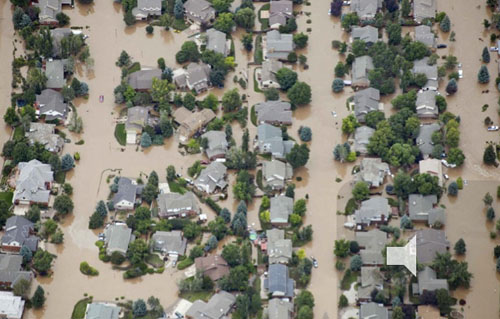The proposal is part of the Federal Emergency Management Agency's plan to overhaul the National Flood Insurance Program, the primary provider of flood insurance in the United States, and would be the most significant change to the program in its history, though it is likely to face opposition from Congress.
In May, FEMA officials told lawmakers that one out of every six dollars paid out by the flood insurance program in the last 30 years went to a building with a history of multiple floods. According to FEMA, properties with two or more losses have received $35.1 billion in claims, nearly half of the total amount paid out as of December.
"Families living in flood-prone areas face life, health, and safety issues," agency officials wrote in a proposal to Congress that included 17 policy changes. "The NFIP has been chastised for making flood insurance available, resulting in rash decisions in floodplains."
Unlike private insurers, the program's managers have "never denied flood insurance coverage to an eligible structure," according to the agency.
FEMA officials are not scheduled to testify at Thursday's Senate Banking, Housing, and Urban Affairs hearing titled "Reauthorization of the National Flood Insurance Program: Protecting Communities from Flood Risk," but the agency's proposed overhaul is likely to be discussed.
Jana Henderson of the Mississippi Emergency Management Agency, Peter Van Doren of the Cato Institute, and Douglas Quinn of the American Policyholder Association will testify at the hearing.
For years, Congress has debated how to modernize the financially troubled flood insurance program, with policymakers divided on how much the public should subsidize the program.
Sen. Bob Menendez (D-NJ), a committee member who has advocated for federal flood insurance reform since Superstorm Sandy in 2012, said Wednesday that the proposal to drop coverage for homeowners in flood zones "runs completely counterintuitive to the program's goals."
"In the unlikely event that this proposal becomes law, it would prohibit new policies for vulnerable homes and small business owners still reeling from the pandemic," he explained.
Since Congress established the flood insurance program in 1968, it has paid out more money to property owners and other expenses than it has collected in premiums from policyholders. According to the Congressional Research Service, it receives approximately $4.6 billion in annual revenue from policyholders in the form of premiums, fees, and other charges.
Flooding is the most common natural disaster in the country. Floods, according to scientists, will become more common in neighborhoods that face new risks from rising sea levels and extreme rainstorms caused by climate change.
In order for residents to purchase insurance, builders, homeowners, and buyers must adhere to the agency's building standards, making it the country's primary policy mechanism for requiring vulnerable neighborhoods to implement climate resilience measures.
FEMA officials stated in their request that the program would seek to drop coverage on properties that have received four claims payments of at least $10,000 each. According to the agency, approximately 20,000 properties fell into this category as of July 2019. Homeowners may be able to regain coverage by making improvements.
Officials from FEMA also proposed that the program stop offering new policies to commercial structures and homes in the country's most flood-prone areas, where properties face at least a 1% chance of flooding each year.
FEMA officials implemented a new policy pricing system in October, recalculating premiums to be more closely aligned with a property's flood risk. Officials stated that the new methodology would raise premiums for higher-value properties while decreasing rates for others.
Program officials are also considering increased new building standards in order to limit flood damages in the first place, which would not necessitate congressional action. The Natural Resources Defense Council and the Association of State Floodplain Managers requested these changes in January 2021.
The National Association of Realtors supports stricter building standards, but the National Association of Home Builders told agency officials in January that "unwarranted regulations that will add to the challenges of producing housing and raise the cost of housing nationwide will only exacerbate the current housing shortage."
According to Joel Scata, senior attorney at the Natural Resources Defense Council, the flurry of recent activity for a program that has long been ignored stems from concerns expressed by members of Congress and their constituents who have been affected by more frequent flooding in recent years.
"Because of the increasing frequency of flood disasters in the United States, there is pressure on the National Flood Insurance Program to change because, in its current form, it is more of a liability than a benefit," he explained.
Flood insurance reform, according to Mr. Scata, does not have the typical partisan divide; rather, it has the attention of both Democratic and Republican lawmakers from coastal states. It also aligns environmental groups with fiscal conservatives who believe the federal government should not subsidize coastal development in high-risk areas.
In their proposal, FEMA officials also urged Congress to cancel the program's $20 billion debt, provide more information about flood risk to home buyers and renters during real-estate transactions, and make policies more affordable for low-income people.
In a three-page letter attached to the proposal, Alice Lugo, the agency's assistant secretary of legislative affairs, said, "Comprehensive and transformative reform is required to transition the NFIP to a sustainable program that balances affordability and fiscal soundness, builds climate resilience, and reduces risk, loss, and disaster suffering."













